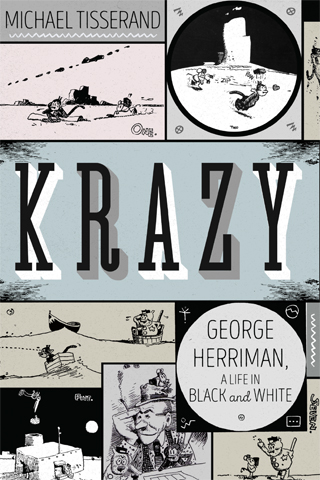
"Krazy: George Herriman, A Life in Black and White," by Michael Tisserand

Cartoons by George Herriman (Courtesy of Fantagraphics Books*)
When George Herriman died in 1944, Time magazine called the creator of the popular "Krazy Kat" comic strip "a figure of almost Franciscan sweetness."
It might seem strange to use a religious reference for a man who was part of the notoriously rascally newspaper world of the early 20th century — think "The Front Page" — and lived in the Hollywood hills. But according to his biographer, New Orleans writer Michael Tisserand, faith played a big part in Herriman's work.
Herriman was born in New Orleans, a deeply Catholic city founded by the French and ruled by France or Spain until the Louisiana Purchase.
"It seems pretty clear to me that religious training was part of his home life as well as an integral part of his school life," Tisserand said in an interview about his book, Krazy: George Herriman, A Life in Black and White.
"In addition to hearing folktales and stories from literature in French, the family participated in every sacrament available to them," said Tisserand, whose book was nominated for the National Book Critics Circle Award and PEN America Award. "Those ideas of faith and fate and destiny and good and evil and sin and virtue were ideas that Herriman was raised with."
And those ideas show up in the "Krazy Kat" strips, which ran until Herriman's death at 63. Sin, evil and punishment, along with Latin words and classical themes, can all be found in the cartoons.
That Herriman's fans included the likes of Ernest Hemingway, Edmund Wilson and e.e. cummings shows that Krazy Kat limned deeper themes than the normal fare of the funny papers.*
The strip took "notions of good and evil and faith and free will, and addressed them all quite actively in the 34 years that Krazy Kat walked among us," Tisserand said.

Herriman's great-grandparents were Stephen Herriman, a white northerner, and Justine Olivier, a free Creole woman of color. They were not married; they couldn't be. A mixed-race marriage would have been illegal, and, later, Stephen Herriman married a white woman.*
In the years that George Herriman's parents and grandparents lived in New Orleans, Catholic churches there were bouncing back and forth between racial inclusion and segregation. The Herrimans worshiped in an integrated church, and the men were part of an integrated Masonic lodge.
But lines hardened and black people were no longer welcome in some of the churches they had previously belonged to.
Eventually, the Herriman family gravitated to St. Augustine Church, which was founded 175 years ago by free people of color and white parishioners and had the distinction of having pews set aside for slaves.
In 1890, the family moved to Los Angeles, making it easier to throw off their racial signifiers in a new place. The future cartoonist was 10 at the time.
Herriman and his brother attended St. Vincent's College, a boys elementary and high school run by Vincentian priests. There, he studied Shakespeare, Cervantes and the ancient Greeks, and learned Latin.
Though Herriman did not openly discuss his race, Tisserand said friends wondered about it anyway, at various times thinking he might have been Greek, Egyptian, German, Irish or Jewish.
Herriman was not afraid to take on racial issues in his work, however. In an early cartoon before he started drawing Krazy, Herriman ridiculed a controversy raging then: whether movie footage of a black boxer annihilating a white one would cause unrest if shown in theaters.
Herriman drew a man "walking up and down the aisle of movie theaters selling 'transformation glasses' that turn whites to blacks and blacks to whites," Tisserand said. "He would take typical stories and typical ideas that he would pick up anywhere, from his reading or from the culture, and make his own turn on them."
Herriman would even use imagery from minstrel shows, but rework that in ways "that reflected a very different attitude about race and his own personal experience about race," Tisserand said.
In the strips, a mouse named Ignatz regularly hurls a brick at Krazy's head. But Krazy "in fact interprets it as this great sign of devotion and love," he said. "Krazy Kat transforming that brick delivered by that little white mouse into an act of love is somehow at the heart of understanding the strip. Transformation would have been at the heart of what he grew up with as a young Catholic.
"That idea that something or someone in front of you might be very different than they appear is at the heart of what I grew up with as a Catholic, and I have to think was influential for his thinking as well," Tisserand said.

Herriman uplifted the lowly, an undisputedly Christian theme. In the early 1970s, Jesuit Fr. Philip Conneally wrote in a tribute to Herriman that in doing so, he "became in a practical way the Herald of the Beatitudes to the people of the United States."
Time's comparison to St. Francis of Assisi is apt, given that the Krazy Kat strip is devoted to animals — a lovable black cat, a mouse and a dog policeman named Officer Pupp.
Herriman's strips related "essential human concerns told through the characters of funny animals," Tisserand said. In fact, Herriman's first comic strip was "a series of Aesop's Fables that he rewrote with happy endings."
But the comparison with Francis doesn't end there. In addition to the saint's well-known reverence for creatures, he also considered the stewardship of the created world an important religious duty.
Herriman's most significant interaction with God's creation was in the Arizona desert, which also provided the landscape for the Kat cartoons.
"When he first went to the desert and went to Arizona, it feels as if a light was switched on and he discovered a new place of beauty that became his home in a way that perhaps he had not experienced since childhood," Tisserand said.

His exposure to Navajo rituals there widened his philosophical outlook. A woman who knew the Herrimans remembers them daily reciting the Navajo "Beauty Prayer," which starts off with the line, "with beauty before me, I walk." Herriman later worked the prayer into a cartoon.
"Whether it was the lessons he learned as a Catholic schoolboy or the lessons he learned from Navajo friends, he gave his own twist or take on something," Tisserand said.

Those who owe an artistic debt to Herriman include Walt Disney, "Calvin and Hobbes" creator Bill Watterson and graphic novelist Art Spiegelman, to name just a few.
Tisserand said "Peanuts" creator Charles Schultz believed that Herriman "inspired him to go deeper and to bring more rich complex topic materials into Peanuts than just the funny antics of little children."
Tisserand gathered material for an article about Herriman when he worked at Gambit, an alternative weekly in New Orleans. As he was leaving his office the Friday before Hurricane Katrina struck in 2005, he moved the papers from the floor to his desk, saving them from the resulting floodwaters.
While still in post-Katrina exile in 2006, Tisserand took in an exhibit of Herriman's work in Milwaukee, reading the strips out loud to his five-year-old son.* And the idea for the book was born.
Tisserand said the Archdiocese of New Orleans "was instrumental in me telling the Herriman story. The records they keep here and the archivists that work at the archdiocese were incredibly helpful."
Finding the name of Herriman's great-grandfather in the sacramental records "allowed me to actually finally put the story together of this white riverboat captain from the North and the free woman of color, Justine Olivier."
*This story has been updated to remove a reference to Pablo Picasso as one of Herriman's fans, to clarify language about Stephen Herriman's marriage, and to correct the age of Tisserand's son. The source for the comic strips has also been corrected.
[Dennis Persica is a former reporter and editor for The Times-Picayune newspaper. From 2012 until 2015, he wrote a weekly column for The New Orleans Advocate newspaper and still occasionally reports for that daily paper.]



